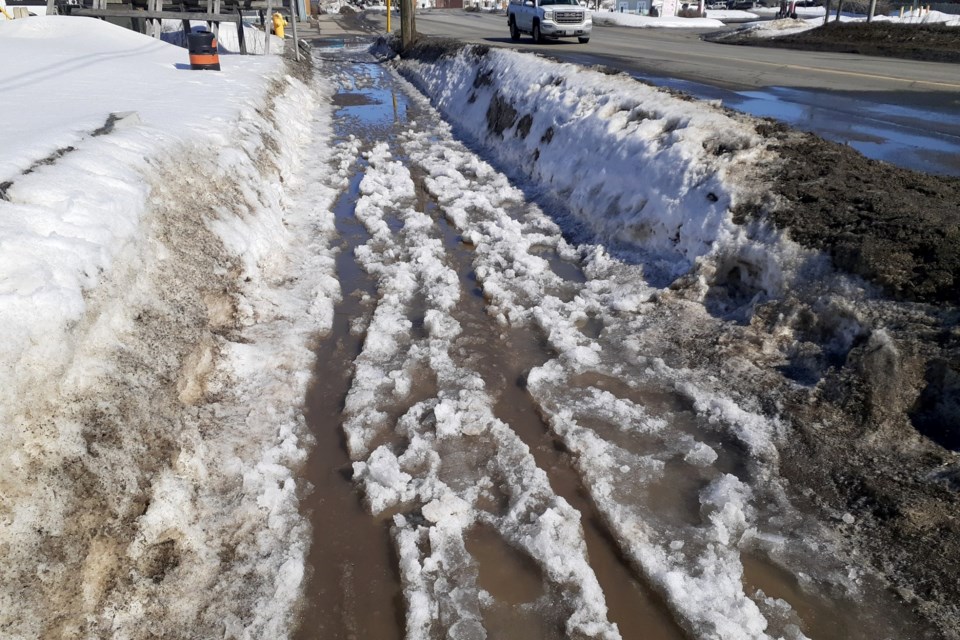Walking is my main way of getting around. My weekly walk for groceries takes me along busy roads. In the winter, I am often climbing over or balancing on snowbanks, wading through ankle-deep ice slush, fording through snow, being careful not to fall on ice, or navigating treacherous ridges.
On my way, I see people in wheelchairs and mothers pushing strollers in the middle of busy traffic because the sidewalks are impassable. Back at home, I hear from people who haven’t gone out for months, losing their independence and health. I hear about near misses on the way to work and medical appointments. I hear from a young friend who broke her ankle badly and is recovering from surgery, after a fall on an icy sidewalk.
There’s a chance for much-needed change with the city’s review of winter sidewalk maintenance. Let’s look at the options presented.
Option C: ‘24/7 sidewalk winter maintenance’ is clearly the only option presented that is going to make things significantly better. It is the only option that will fix the biggest problems with winter sidewalks. The only one that will address the need for more sanding when conditions are icy, faster clearing of sidewalks, more passes during snow storms, and more passes to clear away slush, snowbanks, and snow knocked into sidewalks. It is the only option that would make sidewalks usable for people with a mobility device or stroller.
There is a telling note in the survey: “Similar to snowplows service levels, this option will allow sidewalk plows to be available on a 24/7 basis during the winter months.” Yes, this is the option that recognizes that sidewalk clearing is just as important as road clearing, because just like roads, sidewalks are essential transportation infrastructure.
The cost? Less than 12 cents a day for property owners with a $230,000 house so that their neighbours, family members, and fellow community members can keep their independence and health, and get around their community safely, as everyone should have the right to do.
This is a question of basic accessibility and human rights, and should not even be a debate.
What about the other options?
Option A would start plowing at five centimetres instead of eight. A small improvement, but not one that will make sidewalks accessible to those that need it most. London, Ont., made this change a couple years ago, and found it didn’t reduce the number of complaints.
Option B would see better clearing on main roads, but neighbourhood sidewalks might not be cleared for 48 hours, so how do you get to those main roads? The only choice would be to walk on the street, which is often no choice at all. Kids wouldn’t have a safe way to walk to their neighbourhood school for two days after a snow storm.
In Option D, the city would not clear residential sidewalks at all: property owners would be required to plow the sidewalk in front of their property. Talk about a huge decrease in service, when what’s needed is a big improvement. The big problem with having residents clear the sidewalks is there is no predictable, consistent sidewalk conditions. For someone who relies on good conditions to be able to use the sidewalks, there is no way to know if they can reach their destination.
Let’s imagine you were driving on an important errand, and at any time on a neighbourhood street, you might come across a section that hadn't been plowed, that would make you turn around and go back home. That would never be accepted for drivers and it shouldn't be accepted for people using sidewalks either. Your mode of transportation doesn’t change your need to get to work on time, get to a medical appointment, or pick something up for supper.
Option E is no change. And we all know there needs to be a change for the better.
So that brings us back to Option C — 24/7 sidewalk winter maintenance — which is really the only choice. It simply needs to be done. For basic mobility for all. For human rights. To be an accessible community. To be a senior friendly community. To be a walkable and vibrant community. To allow people to choose active transportation all year round for their own health and the health of the planet. To meet the ‘net zero’ goal of 35 per cent of trips to be on foot or by bike.
Winter is a long season in Northern Ontario, too long not to be able to get around. Our sidewalks need to work for everyone in all seasons: people of all ages, people pushing strollers, people using mobility devices, people with mobility challenges — in short, all of us at some time of our lives. Our winter sidewalks need to be clear and safe to use.
You can fill in the city’s survey until March 24. Go to overtoyou.greatersudbury.ca and click on ‘Winter Sidewalk Maintenance’.
Naomi Grant chairs Coalition for a Liveable Sudbury and is a member of Greater Sudbury Safer Sidewalks.
